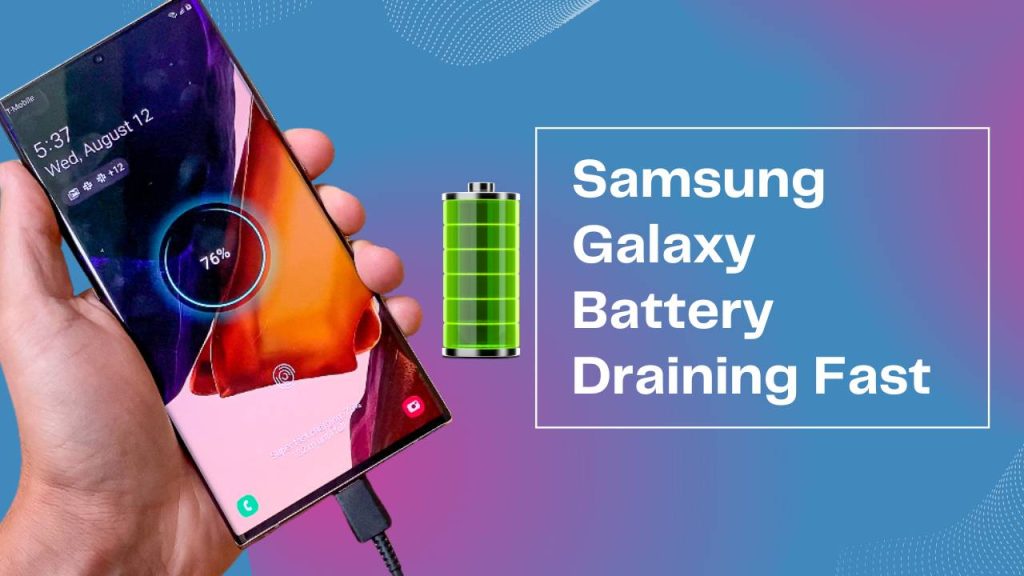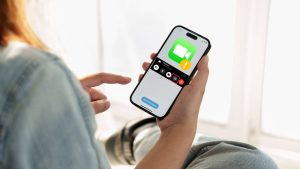Samsung Galaxy user frustrated by how quickly your battery is running out, you’re not alone. Many users have recently reported their Samsung Galaxy battery draining fast, even with minimal usage. Whether own the latest Galaxy S23 Ultra or an older A-series model, this common issue can disrupt your day-to-day smartphone experience.
Get to know through why your Samsung Galaxy battery is draining fast, the most effective ways to fix it, and how to prevent it from happening again. From hidden background apps to software glitches, let’s dive deep into solving this once and for all.
Samsung Galaxy Battery Draining Fast All of a Sudden?
A sudden drop in battery life can feel alarming, especially if it was working just fine the day before. The most common culprits behind Samsung Galaxy battery draining fast include recent software updates, rogue apps consuming power in the background, overheating, or misconfigured system settings.
A few scenarios to consider:
1. Recent Software Updates Can Disrupt Battery Optimization
If recently installed a new One UI update or Android version, this is often the most common cause of sudden battery drain. Updates can sometimes introduce background processes or bugs that weren’t present before. Here’s how:
- Post-update indexing: After a major update, the phone usually re-indexes data, apps, and files. This process can last several hours or even a day, consuming more battery temporarily.
- Background app refresh issues: The update might reset app permissions or background sync settings, causing more apps to refresh unnecessarily.
- New features turned on: Some updates automatically enable new features (like Samsung’s SmartThings, enhanced location services, or battery analytics) that consume more power.
It’s not always the update itself, but what happens after it—reset preferences, system reconfigurations, or even incompatible apps struggling with the new version.
2. High Screen Brightness & Refresh Rate Drain Battery Quickly
Samsung’s AMOLED screens are among the best in the business—but they’re also energy intensive.
- 120Hz Refresh Rate: Many recent Galaxy models (like the S22, S23, or A-series) support 120Hz refresh rates. While this makes animations smoother, it consumes significantly more power compared to 60Hz. Unless you’re gaming or scrolling rapidly, the visual benefit may not justify the battery hit.
- High Brightness: Outdoor visibility enhancements or using maximum brightness drains power rapidly. If you’ve been outside a lot or using adaptive brightness, it might have spiked too high.
- WQHD+ Resolution (on some models): Higher screen resolution also means more power is required. Check if your device is set to its max display resolution unnecessarily.
3. Misconfigured Settings & Power-Hungry Features
Samsung phones come packed with features—but many of them run persistently in the background:
- Always-On Display (AOD): Though it uses minimal power, it can still contribute to battery drain over time.
- Location Services / GPS: If set to “High Accuracy” mode, your phone continuously checks your location using GPS, Wi-Fi, and mobile networks—especially if multiple apps are accessing location data.
- Auto-sync and background data: Services like Gmail, Samsung Cloud, Google Photos, OneDrive, etc., constantly syncing can wear down your battery throughout the day.
- Smart Stay / Edge Lighting / Nearby Device Scanning: These features use sensors or network activity that keeps your device from entering deep sleep mode.
Checking and tweaking these settings can drastically improve your battery longevity.
4. Rogue Third-Party Apps Consuming Background Power
Some apps, especially third-party or poorly optimized ones, can go “rogue” after an update or over time:
- Social media apps like Facebook, Instagram, Snapchat, or TikTok often run background processes to push notifications and update feeds.
- Games or poorly coded utility apps might be stuck in the background even after closing them.
- Battery stats not matching usage: Go to Settings > Battery and Device Care > Battery to check which apps are using more battery than they should.
In some cases, a misbehaving app can cause your CPU to remain active, preventing the phone from entering sleep mode.
5. Overheating & Environmental Factors
If your phone is getting too hot, the battery drains much faster. This can happen due to:
- Heavy usage (gaming, streaming, hotspot, or camera).
- Charging the device while in use.
- Warm weather or direct sunlight exposure.
When the phone gets hot, the system automatically throttles performance and background tasks, which can ironically increase power draw as apps try to recover or restart.
6. Aging Battery or Battery Health Degradation
If your Galaxy device is over a year or two old, or has undergone hundreds of charge cycles, your battery health may have declined. Symptoms include:
- Faster discharge at high loads.
- Unexpected shutdowns at higher percentages.
- Difficulty reaching a full 100% or dropping quickly from 100% to 90%.
Samsung doesn’t show battery health natively like Apple, but you can check it using apps like Samsung Members or third-party tools such as AccuBattery.
7. Network Issues & Signal Fluctuations
Poor signal strength or constant switching between Wi-Fi and mobile data can wear out your battery faster.
- Weak 4G/5G signal: Your phone increases its radio power to stay connected, especially in low-signal areas.
- Wi-Fi disconnections: If your home or office Wi-Fi is unstable, the phone might toggle between networks repeatedly, leading to unnecessary battery usage.
- Hotspot and Bluetooth tethering: These radio-based features drain batteries significantly faster if left on.
8. Malware or Adware on the Device
Though less common, Samsung phones can fall victim to malicious apps, especially when apps are sideloaded from non-Google Play sources.
- These apps might run hidden background processes, display ads on lock screens, or send data over the network—all of which strain the battery.
- You can boot the device in Safe Mode to see if the issue persists—if not, then a third-party app is likely the culprit.
Samsung Galaxy Battery Draining Fast Overnight? Causes & Fixes
Waking up to find that your Samsung Galaxy’s battery has drained by 20-40% overnight can be incredibly frustrating. When you’re not using your phone, it should ideally consume very little power—typically under 5%. If you’re noticing significant overnight battery drain, there are a number of common culprits and effective fixes you can try. Let’s take a deeper dive into both the causes and solutions.
Common Causes of Overnight Battery Drain
1. Background Syncing: Gmail, Social Media, and Backup Apps
One of the primary reasons your phone may drain overnight is background syncing. Many apps, such as Gmail, social media apps (like Facebook, Instagram, and Twitter), and cloud backup services, sync data regularly—even when you’re not actively using your phone.
- Gmail and other email apps regularly check for new emails or updates.
- Social media apps like Facebook, Snapchat, and Instagram continue to update feeds, check for notifications, or even refresh content.
- Backup services (e.g., Samsung Cloud or Google Drive) may run backups at night, consuming both data and power as they upload photos, videos, and app data to the cloud.
This background syncing often runs unchecked, resulting in increased power consumption.
2. Wi-Fi and Mobile Data Left On All Night
Most of us leave Wi-Fi and mobile data turned on overnight, assuming they won’t drain much power while we sleep. However, both of these features can drain your battery if your phone is constantly searching for networks or syncing data.
- Wi-Fi: Your phone constantly searches for networks, even if it’s already connected to one. If the signal is weak or intermittent, the device may expend more power to maintain a stable connection.
- Mobile Data: If you’re in an area with poor reception or weak cellular coverage, your phone works harder to maintain a stable connection, leading to excessive power usage.
In addition, apps running in the background can continue to send and receive data over both Wi-Fi and mobile networks, further depleting your battery.
3. Apps Running in the Background: Facebook, Snapchat, TikTok
Certain apps are notorious for staying active in the background and consuming unnecessary power, even when you’re not actively using them. Facebook, Snapchat, and TikTok are prime examples.
- Facebook and Messenger constantly check for new messages, notifications, and status updates. This can cause the app to remain active, even while you’re asleep.
- Snapchat and TikTok often keep their media feeds updated or refresh content in the background, which results in additional power consumption during idle times.
These apps can also continue to track location or use your phone’s sensors, all of which can add up to significant battery drain overnight.
4. Bloatware and Unnecessary System Apps
Many Samsung devices come pre-loaded with bloatware—unwanted or unnecessary apps that often run in the background. These apps, such as Samsung’s stock apps, promotional apps, or third-party apps, can silently consume power overnight without offering much value to the user.
While some of these apps are essential for system functionality, many are simply there to push updates or advertisements, leading to unnecessary background tasks. Over time, these apps can accumulate and significantly impact your device’s battery life.
Fixes to Reduce Overnight Battery Drain
Dealing with significant overnight battery drain, you can make some adjustments to help reduce the impact and conserve your battery while you sleep.
1. Enable Battery Saver or Bedtime Mode Before Sleeping
Both Battery Saver and Bedtime Mode are powerful tools designed to minimize power usage during periods of inactivity, such as overnight.
- Battery Saver: Activating Battery Saver limits background processes, reduces screen brightness, and restricts app activity to conserve battery power. This is a quick and efficient way to reduce idle power consumption.
- Bedtime Mode: Bedtime Mode (found in Digital Wellbeing) disables notifications, dims the screen, and limits app activity during the hours when you’re likely to be sleeping. This can be customized to suit your sleeping schedule, ensuring your device doesn’t consume unnecessary power during idle periods.
Both modes can significantly reduce the battery consumption of your device while you’re not using it, without requiring you to turn off essential functions entirely.
2. Disable Wi-Fi, Bluetooth, and Mobile Data at Night
While it may seem obvious, turning off Wi-Fi, Bluetooth, and mobile data during the night can make a noticeable difference in reducing overnight battery drain.
- Wi-Fi: If you’re not expecting any updates or data syncing to occur overnight, it’s a good practice to turn off Wi-Fi. If you have Wi-Fi calling enabled, this can still allow you to make and receive calls, but the phone will stop searching for networks.
- Bluetooth: If you don’t need Bluetooth connections overnight (e.g., for smartwatches or headphones), turning it off will help conserve battery.
- Mobile Data: If you’re not using mobile data at night, simply turn it off to avoid unnecessary data exchange.
By switching off these features, you ensure that your phone won’t waste energy searching for signals or maintaining active connections.
3. Use Device Care → Battery → Background Usage Limits
Samsung provides an excellent tool called Device Care that allows you to manage battery usage, particularly when it comes to apps running in the background.
- Navigate to Settings > Battery and Device Care > Battery > Background Usage Limits.
- Here, you can enable the option to Put unused apps to sleep. This will automatically restrict apps from running in the background if they haven’t been used recently, reducing unnecessary power consumption.
Apps that are put to sleep will not use CPU or network resources, which can significantly reduce their impact on battery life. It’s a good idea to go through the list of apps that consume the most battery in this section and restrict any apps that you don’t need running overnight.
4. Check Usage Stats to Identify Problem Apps
Another effective way to stop battery drain overnight is by reviewing battery usage to see which apps have consumed the most power while your phone was idle.
- Go to Settings > Battery and Device Care > Battery > Usage to see a breakdown of which apps are using the most power.
- If you spot any apps that are using an unusually high amount of battery, try uninstalling or restricting them to prevent them from running in the background overnight. For example, if Facebook is consuming a lot of power, you could restrict its background activity in the app settings or uninstall it altogether if you don’t use it frequently.
5. Disable Auto-Sync and Background Data for Apps
Many apps are set to automatically sync in the background, which leads to battery drain over time. You can disable this for specific apps or for all apps to prevent unnecessary syncing during the night.
- In Settings > Accounts and Backup > Accounts, you can disable auto-sync for specific accounts such as Gmail, Facebook, or other cloud-based services.
- You can also restrict background data for apps by going to Settings > Apps, selecting the app, and choosing the Mobile Data and Wi-Fi options to prevent the app from using data in the background.
By adjusting these settings, you can significantly reduce the amount of power consumed by syncing services.
Top 10 Settings to Disable If Samsung Galaxy Battery Is Draining Fast
Samsung Galaxy phones are packed with powerful features and customization options, but some of these features can be significant drains on your battery if left unchecked. Many of these features run in the background without your knowledge, quietly consuming power. By making a few adjustments, you can greatly extend the battery life of your Samsung Galaxy device.
Below is a detailed breakdown of the top 10 settings you should consider disabling if you’re experiencing fast battery drain.
1. Always-On Display (AOD)
The Always-On Display feature is one of the most visually appealing features of Samsung Galaxy phones, providing a quick glance at the time, notifications, and other important information. However, it’s also a significant battery drain. The display is constantly active, even when the phone is idle, consuming power by keeping the screen lit.
- How it drains battery: The AOD function uses a small portion of the AMOLED display, which continues to refresh at a constant rate to show the time and notifications.
- How to disable: Go to Settings > Lock screen > Always On Display, then toggle it off to save battery.
While AOD is convenient for quickly checking the time or notifications, turning it off can lead to a noticeable reduction in battery consumption.
2. High Refresh Rate (120Hz)
Samsung Galaxy devices, especially those with Super AMOLED displays, offer a 120Hz refresh rate for ultra-smooth scrolling and animations. While it enhances the viewing experience, it’s also one of the biggest battery hogs. The faster the refresh rate, the more power the device uses to update the screen.
- How it drains battery: The higher refresh rate requires the GPU to work harder, consuming more energy.
- How to disable: Navigate to Settings > Display > Motion smoothness, then switch from 120Hz to 60Hz. This will reduce the strain on your battery while still providing a smooth user experience.
Switching to 60Hz won’t be as visually fluid as 120Hz, but it’ll make a noticeable difference in how much power your phone consumes.
3. Location Services (GPS)
Location Services are essential for navigation apps and certain features like location-based reminders, but they consume significant battery when active in the background. Your phone constantly tracks your location, even if you’re not using apps that require it.
- How it drains battery: GPS uses the phone’s processor and sensors to continuously track your location, which can quickly drain your battery, especially if you have apps that use location in the background.
- How to disable: Go to Settings > Location, and toggle off the Location switch, or better yet, selectively disable it for individual apps. You can also set it to only use GPS when necessary.
Only enable location services when you’re using navigation or location-specific apps, as unnecessary GPS usage can consume power.
4. Nearby Device Scanning
Samsung devices feature Nearby Device Scanning, which allows your phone to detect and connect to devices like wireless headphones, smartwatches, and other Bluetooth-enabled gadgets. While this feature is useful, it constantly scans for new devices in the background, consuming battery in the process.
- How it drains battery: The scanning process uses Bluetooth and Wi-Fi radios to find nearby devices, keeping your phone’s power consumption high even when you’re not actively using these features.
- How to disable: Go to Settings > Connections > More connection settings, then toggle off Nearby Device Scanning.
Disabling this feature will stop your phone from constantly searching for new devices, which can be particularly helpful if you aren’t regularly pairing your phone with other devices.
5. Wi-Fi Scanning and Bluetooth Scanning
Wi-Fi Scanning and Bluetooth Scanning are two settings designed to improve the accuracy of location services and make it easier to find nearby networks and devices. However, they can use significant battery life by keeping your phone’s Wi-Fi and Bluetooth radios active, searching for networks and devices around the clock.
- How it drains battery: Wi-Fi and Bluetooth continuously search for networks and devices, consuming power, even when you’re not actively using either feature.
- How to disable: Go to Settings > Location > Improve accuracy, and disable both Wi-Fi Scanning and Bluetooth Scanning. This will prevent your phone from constantly scanning for nearby networks and devices.
Turning off these features will prevent your phone from using power unnecessarily to find Wi-Fi networks or Bluetooth devices when you’re not actively connecting.
6. Background App Refresh
Many apps on your Samsung Galaxy phone are set to refresh in the background to provide updates, such as checking for new emails, social media notifications, or news stories. While this feature is convenient, it drains battery by allowing apps to run in the background, even when you’re not using them.
- How it drains battery: Apps are constantly checking for new data, pulling in fresh content, and refreshing themselves even while you’re not actively engaging with them.
- How to disable: Go to Settings > Apps, select each app, then disable the Background data or Background activity option. For apps like email, you can choose to sync data manually instead of automatically refreshing in the background.
By disabling background app refresh, you’ll limit apps from updating data while running in the background, which can conserve significant battery life.
7. Auto-sync Data
Auto-sync is a feature that automatically updates your contacts, calendar, and other accounts (like email or cloud storage) without you having to manually sync them. While this feature is useful for ensuring your data is always up-to-date, it can also lead to battery drain, especially if you have multiple accounts syncing simultaneously.
- How it drains battery: The phone uses data in the background to sync multiple accounts, which can add up over time and consume battery.
- How to disable: Go to Settings > Accounts and Backup > Accounts, then turn off Auto-sync for individual accounts or for all accounts. You can also choose to sync manually when needed.
Turning off auto-sync will reduce background data activity, helping to preserve battery life when you don’t need constant updates.
8. Push Notifications for Unnecessary Apps
Push notifications are a great way to stay updated on important events, but they also consume power because they continuously check for updates, even when you’re not using the app.
- How it drains battery: Notifications constantly use network data and power the phone’s display and vibration motors, which can add up over time.
- How to disable: Go to Settings > Apps, select an app, and toggle off Allow Notifications for apps that don’t require constant alerts (e.g., games or less important apps).
By disabling push notifications for unnecessary apps, you reduce the frequency of background activity, which helps save battery power.
9. Edge Panels and Edge Lighting
Edge Panels and Edge Lighting are unique features designed to make the user interface visually engaging by showing quick-access shortcuts and lighting effects along the edge of the screen. While they add to the aesthetics, they also consume power, especially when the lighting is active or when panels are in use.
- How it drains battery: The Edge Panels require constant background processing to keep them active, and Edge Lighting uses the screen’s AMOLED display to create lighting effects.
- How to disable: Go to Settings > Display > Edge screen, then toggle off both Edge Panels and Edge Lighting.
Disabling these features will prevent extra visual effects and background processing that aren’t essential for everyday use.
10. Google Assistant Hotword Detection
The Google Assistant Hotword Detection feature keeps your phone constantly listening for the phrase “Hey Google” to activate the assistant. While this is useful for hands-free operation, it requires the microphone and other sensors to be active in the background, which can drain battery life.
- How it drains battery: Google Assistant is always listening for the hotword, keeping the microphone and other sensors active.
- How to disable: Go to Settings > Google > Account Services > Search, Assistant & Voice > Google Assistant, then turn off the Voice Match option that enables hotword detection.
Disabling hotword detection can help save battery, particularly if you don’t use Google Assistant frequently.
Samsung phones are powerful, but like any high-performance device, they require a little optimization. By following the above guide, you can regain control of your battery and enjoy smoother, longer-lasting performance from your Galaxy device.
FAQs
1. Why is my Samsung Galaxy battery draining so fast?
Common causes include background apps, high screen brightness, and recent software updates. Check your battery usage settings for specifics.
2. How can I stop my Samsung Galaxy battery from draining so fast?
Turn off unused settings, disable background apps, reduce screen brightness, and enable battery saver mode for longer battery life.
3. Is my Samsung Galaxy battery draining fast after an update?
After updates, your phone might re-index apps or download updates in the background. It’s normal for battery usage to be higher for a few days.
4. Why does my Samsung Galaxy battery drain overnight?
Overnight drain is often caused by background syncing, Wi-Fi, GPS, or apps running in the background. Disable these features for better overnight battery life.
5. Can apps cause my Samsung Galaxy battery to drain fast?
Yes, apps that run in the background or poorly optimized apps can consume excessive battery. Check your battery usage in settings to identify culprits.
6. How can I check which apps are draining my Samsung Galaxy battery?
Go to Settings → Battery → Battery Usage to see which apps are using the most power. You can then restrict or uninstall those apps.
7. Does high screen brightness cause my Samsung Galaxy battery to drain faster?
Yes, high screen brightness and high refresh rates can consume more power. Lower your brightness or switch to 60Hz refresh rate for better battery life.
8. Should I use Battery Saver mode on my Samsung Galaxy?
Yes, Battery Saver mode limits background processes, reduces brightness, and helps improve battery life when you’re running low.
9. Why is my Samsung Galaxy battery draining fast even when not in use?
This could be due to background syncing, apps running continuously, or even a misconfigured setting. Try disabling unnecessary settings like Always-On Display.
10. How can I improve battery life on my Samsung Galaxy?
Turn off unneeded settings (like location, Bluetooth), limit background apps, use dark mode, and keep your phone software updated for optimal battery performance.






